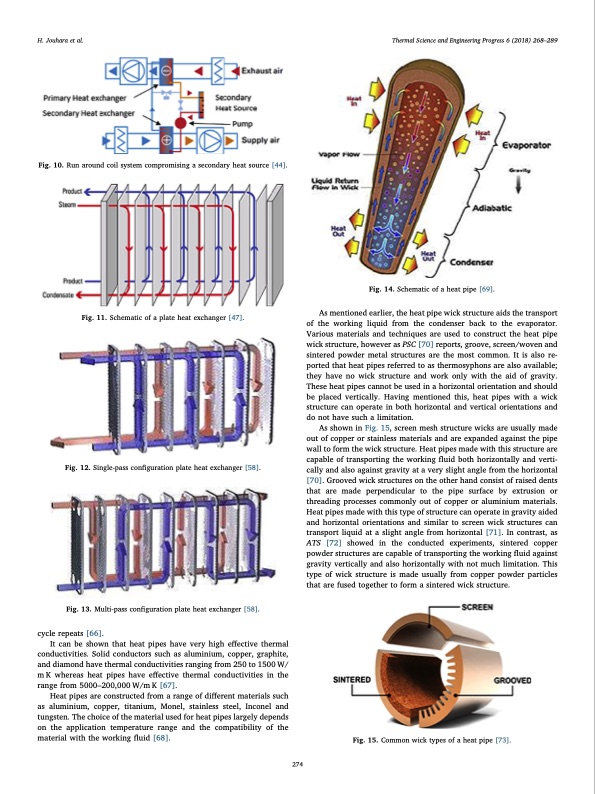
PDF Publication Title:
Text from PDF Page: 008
H. Jouhara et al. Thermal Science and Engineering Progress 6 (2018) 268–289 Fig. 10. Run around coil system compromising a secondary heat source [44]. Fig. 11. Schematic of a plate heat exchanger [47]. Fig. 12. Single-pass configuration plate heat exchanger [58]. Fig. 13. Multi-pass configuration plate heat exchanger [58]. cycle repeats [66]. It can be shown that heat pipes have very high effective thermal conductivities. Solid conductors such as aluminium, copper, graphite, and diamond have thermal conductivities ranging from 250 to 1500 W/ m K whereas heat pipes have effective thermal conductivities in the range from 5000–200,000 W/m K [67]. Heat pipes are constructed from a range of different materials such as aluminium, copper, titanium, Monel, stainless steel, Inconel and tungsten. The choice of the material used for heat pipes largely depends on the application temperature range and the compatibility of the material with the working fluid [68]. Fig. 14. Schematic of a heat pipe [69]. As mentioned earlier, the heat pipe wick structure aids the transport of the working liquid from the condenser back to the evaporator. Various materials and techniques are used to construct the heat pipe wick structure, however as PSC [70] reports, groove, screen/woven and sintered powder metal structures are the most common. It is also re- ported that heat pipes referred to as thermosyphons are also available; they have no wick structure and work only with the aid of gravity. These heat pipes cannot be used in a horizontal orientation and should be placed vertically. Having mentioned this, heat pipes with a wick structure can operate in both horizontal and vertical orientations and do not have such a limitation. As shown in Fig. 15, screen mesh structure wicks are usually made out of copper or stainless materials and are expanded against the pipe wall to form the wick structure. Heat pipes made with this structure are capable of transporting the working fluid both horizontally and verti- cally and also against gravity at a very slight angle from the horizontal [70]. Grooved wick structures on the other hand consist of raised dents that are made perpendicular to the pipe surface by extrusion or threading processes commonly out of copper or aluminium materials. Heat pipes made with this type of structure can operate in gravity aided and horizontal orientations and similar to screen wick structures can transport liquid at a slight angle from horizontal [71]. In contrast, as ATS [72] showed in the conducted experiments, sintered copper powder structures are capable of transporting the working fluid against gravity vertically and also horizontally with not much limitation. This type of wick structure is made usually from copper powder particles that are fused together to form a sintered wick structure. Fig. 15. Common wick types of a heat pipe [73]. 274PDF Image | Waste Heat Recovery Technologies and Applications

PDF Search Title:
Waste Heat Recovery Technologies and ApplicationsOriginal File Name Searched:
1-s20-S2451904918300015-main.pdfDIY PDF Search: Google It | Yahoo | Bing
NFT (Non Fungible Token): Buy our tech, design, development or system NFT and become part of our tech NFT network... More Info
IT XR Project Redstone NFT Available for Sale: NFT for high tech turbine design with one part 3D printed counter-rotating energy turbine. Be part of the future with this NFT. Can be bought and sold but only one design NFT exists. Royalties go to the developer (Infinity) to keep enhancing design and applications... More Info
Infinity Turbine IT XR Project Redstone Design: NFT for sale... NFT for high tech turbine design with one part 3D printed counter-rotating energy turbine. Includes all rights to this turbine design, including license for Fluid Handling Block I and II for the turbine assembly and housing. The NFT includes the blueprints (cad/cam), revenue streams, and all future development of the IT XR Project Redstone... More Info
Infinity Turbine ROT Radial Outflow Turbine 24 Design and Worldwide Rights: NFT for sale... NFT for the ROT 24 energy turbine. Be part of the future with this NFT. This design can be bought and sold but only one design NFT exists. You may manufacture the unit, or get the revenues from its sale from Infinity Turbine. Royalties go to the developer (Infinity) to keep enhancing design and applications... More Info
Infinity Supercritical CO2 10 Liter Extractor Design and Worldwide Rights: The Infinity Supercritical 10L CO2 extractor is for botanical oil extraction, which is rich in terpenes and can produce shelf ready full spectrum oil. With over 5 years of development, this industry leader mature extractor machine has been sold since 2015 and is part of many profitable businesses. The process can also be used for electrowinning, e-waste recycling, and lithium battery recycling, gold mining electronic wastes, precious metals. CO2 can also be used in a reverse fuel cell with nafion to make a gas-to-liquids fuel, such as methanol, ethanol and butanol or ethylene. Supercritical CO2 has also been used for treating nafion to make it more effective catalyst. This NFT is for the purchase of worldwide rights which includes the design. More Info
NFT (Non Fungible Token): Buy our tech, design, development or system NFT and become part of our tech NFT network... More Info
Infinity Turbine Products: Special for this month, any plans are $10,000 for complete Cad/Cam blueprints. License is for one build. Try before you buy a production license. May pay by Bitcoin or other Crypto. Products Page... More Info
| CONTACT TEL: 608-238-6001 Email: greg@infinityturbine.com | RSS | AMP |